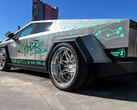Tesla is proposing a new industry-wide standard for low-voltage automotive connectors based on the Cybertruck's 48V system, with the hope to achieve the same success it had with the global adoption of its North American Charging Standard (NACS).
The 48V system of the Cybertruck and other vehicles has numerous advantages before the old 12V low-voltage standard that is getting a bit long in the tooth as it is often not enough to power all the modern driver-assist computers, infotainment systems, or drive-by-wire motors.
The Cybertruck's rear wheel steering, for example, would've been very hard to pull off if not for the power that the 48V system allows sending to the motors that drive it, says Tesla's chief engineer.
The 48V standard allows for one and the same amount of power to be delivered with a quarter of the current, slimming down the cables needed, and simplifying the low-voltage architecture of modern vehicles.
Tesla says that it now requires more than 200 links with an ever-increasing number of connector types, so it is proposing a new Low-Voltage Connector Standard (LVCS) to the industry. Tesla's LVCS would reduce the 48V electrical systems in vehicles to just six connector types that cover more than 90% of the typical applications.
This standardization unlocks further operational efficiencies, cost reductions and manufacturing automation.
The connectors come in miniaturized packaging, too, all the while they use independent secondary locks and durable single wire sealing. Tesla also tips that its LVCS connectors conform to the 48V spacing and light-blue coloring standards, saying that they are purpose built for the electrical needs of autonomous vehicles.
Get the 80A Tesla Gen 2 Wall Connector with 24' cable on Amazon


















